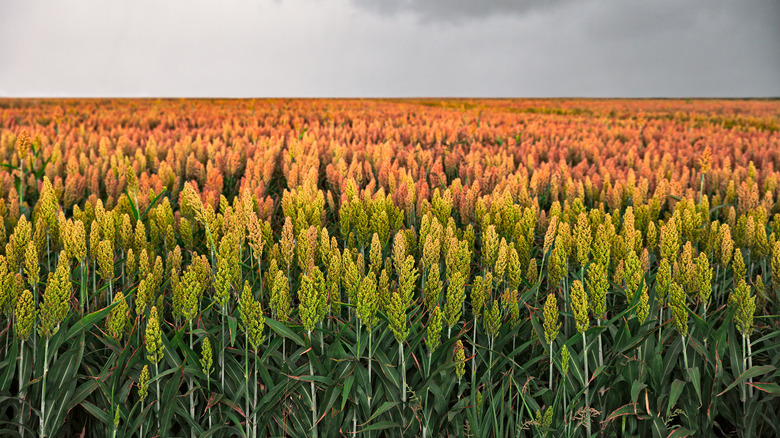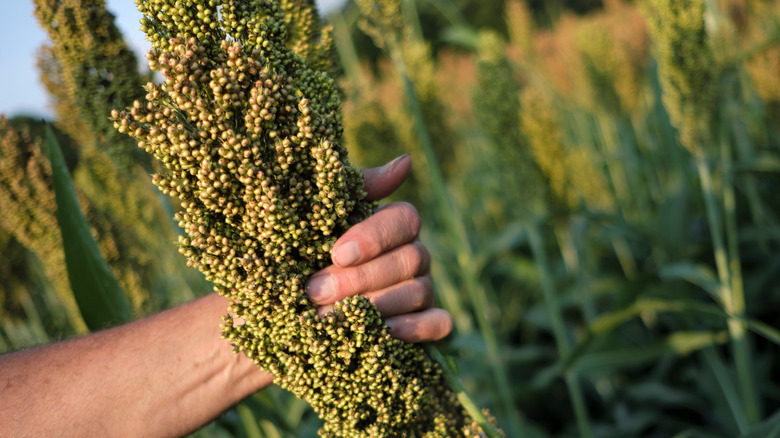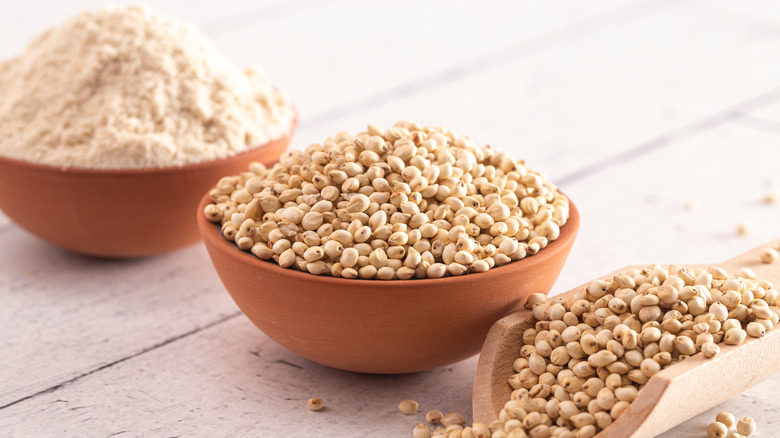Most Of The World's Sorghum Comes From This Country
It's no secret that the American diet is loaded with sugar with upwards of 20 teaspoons consumed daily, reports Healthline. But, this isn't a new phenomenon. Americans are quite long in the sweet tooth and have for eons used sorghum as a sweetener — especially when imported Caribbean sugar cane, and a trade controlled by Southern sugar plantations became scarce during the American Civil War. "It was a political decision,"James Beard award-winning author, Ronni Lundy told Citizen Times.
But, think again if you think sorghum only has a sweet side. This ancient grain's origins can be traced back to 8000 B.C. near the Egyptian-Sundanese border where it proved quite the versatile crop adapting from the Afro-Alpine summits of Ethiopia to the semi-arid climate of Sahel, according to the United Sorghum Checkoff Program.
By the 1700s when it arrived to America via the trans-Atlantic slave trade, it became known as "guinea corn" and African-Americans made everything from baked goods to brooms with it, and even fed the chickens. Just as in its native lands, sorghum rose to the prolific challenge of sweeping America's vast agrarian landscape. Today, U.S. farmers raise the crop to be used in many applications — cereal, biomass, and syrup to name a few — with 373 million bushels produced on American soil in 2020, making the United States the largest producer of grain sorghum.
Why sorghum?
American botanist and campaigner for crop plant biodiversity conservation, Jack Harlan, wrote in a 1971 paper, "Because of its versatility and adaptation, sorghum is one of the really indispensable crops required for the survival of humankind," per National Sorghum Producers. Also called Milo, sorghum requires less water and fertilizer than corn, America's top cash crop, appealing to resource conscious farmers. Additionally, the USDA reveals sorghum as a crop that the Biden Administration aims to support U.S. farmers by expanding and streamlining double crop insurance coverage to over 870 counties in hopes of steadying food prices.
Grown and harvested much in the same way as corn, sorghum's grains range in color from red, orange, bronze, tan, white, and black. The grain is found on the plant's head and is harvested in the fall depending upon where it's grown, which is primarily within the American Sorghum Belt extending from South Dakota to South Texas.
What's more, it's a non-GMO grain that's gluten free, making sorghum ideal for those with gluten sensitivities or who have celiac disease. Packing a nutritional punch with 5 grams of protein and 12% of the daily recommended value of iron, WebMD also notes its powerful health benefits. These types of super food strength is why entities such as the US School Lunch Program are also hopping on sorghum's bandwagon.
How is it used?
Sorghum's sweet, nutty profile has become a staple in the American larder with the tan, cream, and white sorghum primarily used for flour, often called jowar flour, making it a preferred alternative for gluten-free baking. Bob's Red Mill is a popular version you can find in most grocery stores. The antioxidant-rich black and burgundy varieties are used for other culinary components such as cereal.
But, let's face it. Americans love their sweet stuff, including sweet sorghum which is harvested for the stalks that are crushed like sugar cane or beets for their syrup. It can also be used to produce spirits such as whiskey and Baijiu, a traditional Chinese liquor. Yet, humans aren't the only consumers. Depending upon the variety, you'll find this potent product grown as grazing pasture, hay, silage, and green chop for livestock with one caveat — its harvest timing differs slightly from that of corn silage. It's also a healthful additive in pet food for companies such as Taste of the Wild.
Even still, this robust grass cultivar could present a "home-grown resource" in the renewable transportation fuel arena as a bio-butanol. It's too soon to tell how far down the road this toothsome little grain will take us, but, with more than 44 million tons produced and harvested worldwide, it's something to chew on.
Add sorghum to your ingredient list
If you're not acquainted with sorghum in recipes, an excellent entry point is an easy granola recipe like this one adapted from Sam Kincaid of Reap Food Group that uses the grain in three ways: whole cooked sorghum kernels, sorghum flour, sorghum syrup.
Epicurious shares a sorghum and apple sticky pudding recipe by an Eastern-Kentucky-born chef Colin Perry. As executive chef at Dinette Triple Crown, Perry introduces Canadians to Southern foodways such as how sorghum can easily be swapped for maple syrup. "I tend to use a lot of maple syrup in my cooking up here, because it's so delicious and so accessible. But sometimes the taste of sorghum is the only taste that will do," he says. With his inclusion of leaf lard, cornmeal, buttermilk, and bourbon in the recipe, there's no denying its Southern roots.
The versatile grain can also be used in savory applications. The sweet-and-sour umami notes that sorghum sings so well harmonizes with other umami-rich foods like in Cookinglight's mushrooms and miso grain bowl. The recipe incorporates leftover sorghum cooking liquid along with butter and a quick whisk of miso to create a risotto effect out of whole-grain sorghum. The fragrant addition of sautéed shallots, scallions, and mushrooms carry this savory dish with no refrain.
So if you're looking for a sweetener to balance out a sweet or savory dish, try giving sorghum a try for an added depth of flavor.



